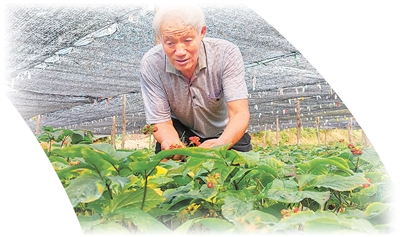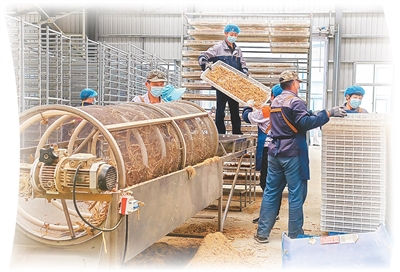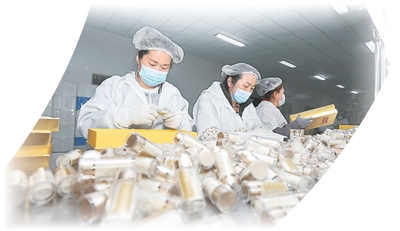American ginseng, native to North America, was once a rare and expensive import in China, valued for its medicinal properties. In the 1980s, Wendeng district in Weihai city, east China's Shandong Province, began trial cultivation of American ginseng.
After more than four decades of research and development, Wendeng has become the country's leading production hub for American ginseng.
Wendeng now produces 8,000 tonnes of fresh American ginseng and 2,200 tonnes of dried ginseng each year, accounting for nearly 60 percent of China's total production and 30 percent of the global supply. The district's ginseng industry has grown into a 10 billion yuan ($1.4 billion) market, establishing Wendeng as China's leading American ginseng production center.

Photo shows Wang Wenshui, a ginseng grower, in a ginseng field in Wendeng district, Weihai city, east China's Shandong Province. (Photo/Guo Yancheng)
The district's success largely stems from pioneer Wang Wenshui, now nearly 70, who began growing American ginseng in Zhangjiachan town, Wendeng.
Wang started cultivating traditional Chinese medicinal herbs in 1979 after completing his military service, working under veteran herbalist Wang Jizhen's guidance.
In 1981, the pair planted 11 American ginseng seeds provided by a company. Eight sprouted successfully, marking the beginning of Wendeng's ginseng industry.
After six years of trials, experts endorsed large-scale cultivation in October 1987 following successful farmland tests.
In the 1990s, Wendeng became the first region in China to promote large-scale American ginseng cultivation, breaking the foreign monopoly on production. Over time, Wang Wenshui trained more than 500 major growers and 3,000 farmers in cultivation techniques. Today, Wendeng's American ginseng cultivation area has stabilized at over 50,000 mu (about 3,333 hectares).
Wendeng's success stems from more than pioneering farmers — the district benefits from ideal geographical and climatic conditions, standardized cultivation practices and digital technology adoption.
An intelligent monitoring platform at the Wendeng American ginseng building tracks data from nearly 10,000 mu of ginseng fields, according to Zhou Xiaojiang, secretary-general of the Zhangjiachan town American ginseng industry association. Internet-of-Things devices and sensors collect environmental data to provide early pest warnings and guide farming decisions.
At a ginseng cultivation facility in Zhaiyanjia village, cameras and sensors are installed in the fields, while a nearby ground-based climate station monitors American ginseng from planting through harvest.

Workers work in a workshop of Weihai Wendeng Daodi Ginseng Industry Development Co., Ltd. in Wendeng district, Weihai city, east China's Shandong Province. (Photo/Guo Yancheng)
"We used to rely solely on experience, but now we let data guide us to fertilize and apply pesticides," said Li Lin, head of the base. "Digital cultivation makes the entire process controllable and efficient."
To ensure quality, Wendeng has promoted strict standardization. State-owned enterprises led by Weihai Wendeng Daodi Ginseng Industry Development Co., Ltd. have spearheaded the creation of 23 standards, covering seedling breeding, planting and pest control. Farmers who follow these standards earn 2-4 yuan per kilogram above market prices, encouraging adherence to quality protocols.
Meanwhile, Shandong Yiyang Biotechnology Group Co., Ltd. invested 8 million yuan in testing equipment and spent two years developing a ginseng quality traceability system, now adopted by more than 10 local enterprises.
The results are clear: Wendeng ginseng contains ginsenoside levels up to 8.8 percent, higher than imports, and selenium content is eight times greater. Wendeng American ginseng is recognized as a geographical indication product of China.
Since the National Health Commission and the State Administration for Market Regulation approved American ginseng as a food ingredient in November 2023, over 30 Wendeng ginseng enterprises expanded into nine product categories, creating more than 240 varieties of deep-processed ginseng products, ranging from oral liquids to substitute teas.

Workers pack American ginseng products at the workshop of Shandong Yiyang Biotechnology Group Co., Ltd. in Wendeng district, Weihai city, east China's Shandong Province. (Photo/Wang Yanbo)
In recent years, the district has intensified marketing efforts, actively promoting the "Wendeng American ginseng" regional brand. Wendeng has hosted an annual American ginseng cultural festival for eight consecutive years to showcase the industry.
Wendeng ginseng products were featured at trade exhibitions in the Yangtze River Delta and Guangdong-Hong Kong-Macao Greater Bay Area last year. It has been ranked among the top 100 Chinese regional public agricultural product brands most favored by consumers.
Wendeng plans further industry upgrades in the coming years. "We will focus on quality seed breeding and protection, deepen standardized and intelligent cultivation, expand the development of products, and enhance brand promotion," said Qiao Xinyue, Party chief of Wendeng district.
"By extending the industrial chain and enhancing the value chain, we aim to continuously brighten the name card of 'Wendeng American ginseng' to boost farmers' incomes and inject strong momentum into comprehensive rural revitalization," Qiao added.
(Source: People's Daily)
